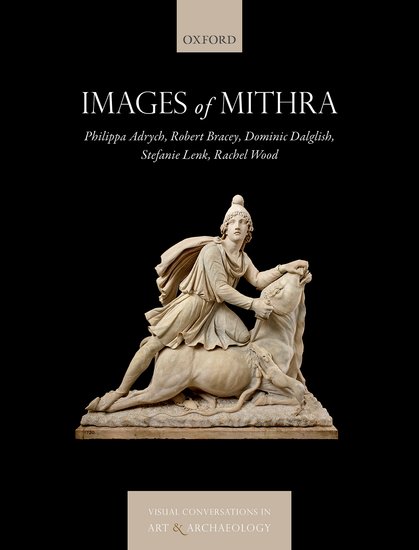Mithras to the Romans, Mihr and Mithra in ancient Persia, Miiro in Kushan Bactria, this figure is not without allure. These names – similar yet distinct, that applied to figures with much in common, but equally a great deal to distinguish them – sparked the very simple question, what’s in a name?
‘Images of Mithra‘, published last week with Oxford University Press, is the first in a new series of works, ‘Visual Conversations’ that aims to tackle a variety of questions about the study of material culture and religion. Over the last two and half years, five members of the project have been presenting, writing, commenting, re-writing, and re-commenting on the book, in what has been a collaborative venture from start to finish. We first started to discuss this question of the significance of names in a perhaps unlikely forum, over lunch. Given that the figure has provoked his fair share of controversy, however, this relaxed environment was not without its merits.

Mithra has the most incredible history – he is a god in the Sanskrit poetry of the Rig Veda, and a guarantor of oaths and contracts in Persia; elsewhere he is a special god of kings and emperors, but in the Roman world he appears to have been at the centre of Mystery cult. Can we understand all of these appearances in concert? Should we understand this figure as one god, and what are the implications if we do or don’t?
The mystery and intrigue surrounding Mithra is far from a modern phenomenon, and indeed appears to have inspired some of the more fantastic notions that surround him. With many different guises, and appearances across thousands of miles and several millennia, the topic hardly wants for both academic and more popular attention – ‘Mushrooms, Myth & Mithras: The Drug Cult that Civilised Europe’ is a particular favourite, and did you know that Martin Luther King once wrote about Mithra, too? Drugs, blood, light, dark – Mithra is often made to have everything, inspiring scholars in the West in particular because of the tantalising similarities held to exist between nascent Christian worship and that of Mithras in the Roman empire. What binds many of these enquiries together, for better or worse, is the central question of the strength of connection from one appearance of Mithra to another.

For some, the truth of this figure has always lain concealed in the mass of texts, images, and inscriptions, to be revealed only upon the clever decipherment of the connections that are thought to inherently bind the evidence. By contrast, others have long doubted the usefulness of whatever links might be discerned in terms of how they might help us understand the figure of Mithra in any of the places we find him. When we began working on this book, the looming presence of these great debates was stifling – some of the most accomplished minds from various fields have laboured over these questions for more than a century, so it was not entirely obvious what we might hope to add. Whether or not we’ve achieved anything is not for us to say, but what we’ve tried to do is to think from the evidence, not from these debates.
Ancient religion had a fundamental basis in material culture. The significance of images of gods and where we find them, therefore has a crucial role to play in the study of ancient forms of worship. Over the course of the work, we look at six different contexts in which we find images of Mithra. In each chapter, we start from a single image, gradually moving outwards to build up an appreciation of its context and place in the wider world. It is from this point that we hope to usefully compare appearances of Mithra from far flung contexts – only by respecting our evidence, can we usefully integrate it.
Over the next few weeks, each of the authors of the work will be discussing some of the questions and the issues that arose in writing their chapters. On 7th June, in collaboration with TORCH, and the Oxford Classics department, we will be hosting a discussion of the book, and a short series of presentations looking to future projects in the same collaborative vein – this is a public event and all are welcome to attend.
===
Introduction
1: Reconstructions: Mithras in Rome
2: Patrons and Viewers: Dura-Europos
3: Settings: Bourg-Saint-Andéol
4: Identifications: Mihr in Sasanian Iran
5: Interpretations: Miiro in Kushan Bactria
6: Syncretisms: Apollo-Mithras in Commagene
Conclusions
Epilogue – Quetzalcoatl and Mithra
===
Author: Dominic Dalglish

